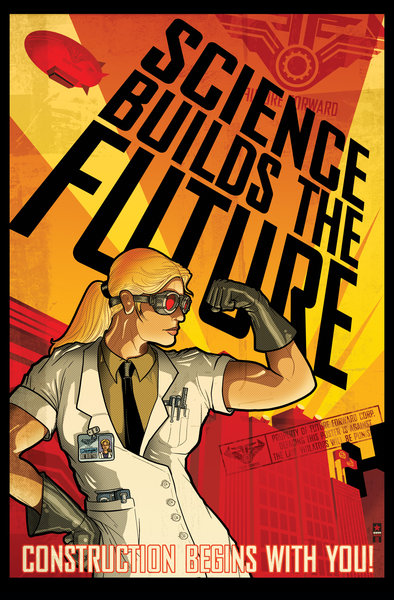
Sadly I missed the recent #isScienceBroken event at UCL, which from all reports was a smashing success. At the moment i’m just terribly focused on finishing up a series of intensive behavioral studies plus (as always) minimizing my free energy, so it just wasn’t possible to make it. Still, a few were interested to hear my take on things. I’m not one to try and commentate an event I wasn’t at, so instead i’ll just wax poetic for a moment about the kind of Science future i’d like to live in. Note that this has all basically been written down in my self-published article on the subject, but it might bear a re-hash as it’s fun to think about. As before, this is mostly adapted from Clay Shirky’s sci-fi vision of a totally autonomous and self-organizing science.
Science – OF THE FUTURE!
Our scene opens in the not-too distant future, say the year 2030. A gradual but steady trend towards self-publication has lead to the emergence of a new dominant research culture, wherein the vast majority of data first appear as self-archived digital manuscripts containing data, code, and descriptive-yet-conservative interpretations on centrally maintained, publicly supported research archives, prior to publication in traditional journals. These data would be subject to fully open pre-and post-publication peer review focused solely on the technical merit and clarity of the paper.
Having published your data in a totally standardized and transparent format, you would then go on write something more similar to what we currently formulate for high impact journals. Short, punchy, light on gory data details and heavy on fantastical interpretations. This would be your space to really sell what you think makes those data great – or to defend them against a firestorm of critical community comments. These would be submitted to journals like Nature and Science who would have the strictly editorial role of evaluating cohesiveness, general interest, novelty, etc. In some cases, those journals and similar entities (for example, autonomous high-reputation peer reviewing cliques) would actively solicit authors to submit such papers based on the buzz (good or bad) that their archived data had already generated. In principle multiple publishers could solicit submissions from the same buzzworthy data, effectively competing to have your paper in their journal. In this model, publishers must actively seek out the most interesting papers, fulfilling their current editorial role without jeopardizing crucial quality control mechanisms.
Is this crazy? Maybe. To be honest I see some version of this story as almost inevitable. The key bits and players may change, but I truly believe a ‘push-to-repo’ style science is an inevitable future. The key is to realize that even journals like Nature and Science play an important if lauded role, taking on editorial risk to highlight the sexiest (and least probable) findings. The real question is who will become the key players in shaping our new information economy. Will today’s major publishers die as Blockbuster did – too tied into their own profit schemes to mobilize – or will they be Netflix, adapting to the beat of progress? By segregating the quality and impact functions of publication, we’ll ultimately arrive at a far more efficient and effective science. The question is how, and when.
note: feel free to point out in the comments examples of how this is already becoming the case (some are already doing this). 30 years is a really, really conservative estimate 🙂